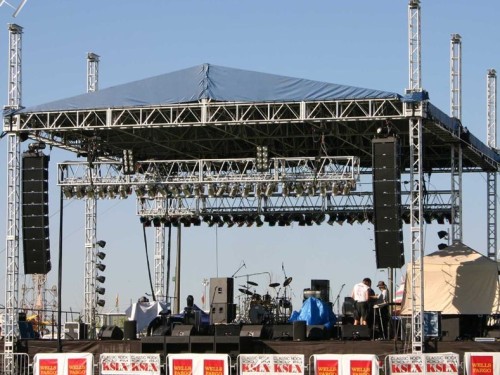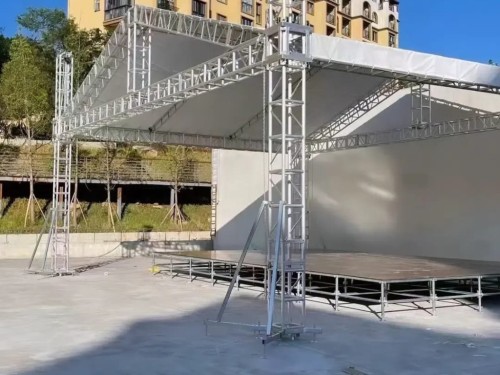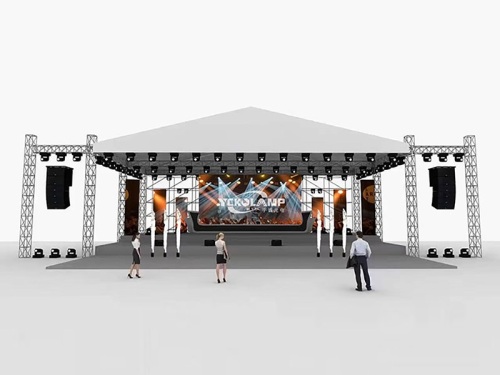

Truss with lighting for swimming pool in USA:
Designing a "truss with lighting" for a "swimming pool" in the USA involves structural engineering, electrical safety, and compliance with local building codes. Below is a step-by-step guide to help you plan and execute this project:
1. Determin the purpose & design requirements:
Functionality: Will the truss support lighting only, or also speakers, cameras, or shade structures?
Aesthetic Style: Modern, minimalist, or decorative?
Lighting Type: LED strips, spotlights, underwater lights, or a combination?
Pool Type: In-ground or above-ground? Saltwater or chlorine? (Affects material corrosion resistance.)
2. Choose the Right Truss Material:
Aluminum: Lightweight, corrosion-resistant (ideal for pool environments).
Stainless Steel: Stronger but more expensive; needs proper coating for saltwater pools.
Galvanized Steel: Budget-friendly but requires maintenance to prevent rust.
Powder-Coated Finishes: Enhance durability and aesthetics.
3. Lighting Options for Pool Truss:
| Type | Best for | Pros | Cons |
| LED strip lights | Accent lighting | Energy-efficient, customizable colors | Needs waterproofing |
| Recessed spotlights | Task lighting | Bright, directional light | Higher installation cost |
| Fiber optic lighting | Decorative effects | No electricity near water, safe | Less bright than LEDs |
| Submersible LEDS | Under water effects | Waterproof, vibrant colors | Requires professional installation |
4. Electrical & Safety Compliance (USA Standards):
NEC (National Electrical Code) Article 680: Governs pool lighting and electrical safety.
Low Voltage (12V or 24V): Preferred for safety (transformers required).
GFCI Protection: Mandatory for all pool-area electrical circuits.
Wet/Niche Ratings: Fixtures must be rated for wet locations.
UL Listing: Ensure all lighting components are UL-certified for pools.
Conduit & Wiring: Use waterproof conduit (PVC or liquid-tight flexible metal).
5. Structural Considerations:
Load Capacity: Account for wind, snow (if outdoors), and dynamic loads (e.g., hanging speakers).
Foundation: Secure truss with concrete footings or anchored posts.
Span & Height: Depends on pool size; consult an engineer for spans >20 ft.
Permits: Check local building codes (some areas require engineering approval).
6. Installation Steps:
Design & Engineering – Hire a structural engineer if needed.
Permit Approval – Submit plans to the local building department.
Truss Assembly– Pre-fabricate or weld on-site.
Lighting Wiring– Use waterproof connectors and conduits.
Mounting – Secure truss to footings or pool deck.
Testing– Verify lighting and structural integrity.
7. Maintenance Tips:
Inspect for corrosion annually.
Check electrical connections for moisture intrusion.
Clean lenses and replace burnt-out LEDs promptly.
8. Cost Estimate (Approximate):
| Component | Cost range |
| Aluminum truss | $500-$3000+ |
| LED Lighting System | $200 – $2,000 |
| Professional Installation | $1,500 – $5,000 |
| Permits & Engineering | $500 – $2,000 |
9. Final Thoughts:
A well-designed truss with lighting can enhance both "safety" and "ambiance" around your pool. Always work with licensed "electricians" and "contractors" familiar with **NEC Article 680** to ensure compliance. For large or complex setups, consult a "structural engineer".
Would you like help with a "specific design layout" or "lighting automation" (smart controls)? Let me know!







